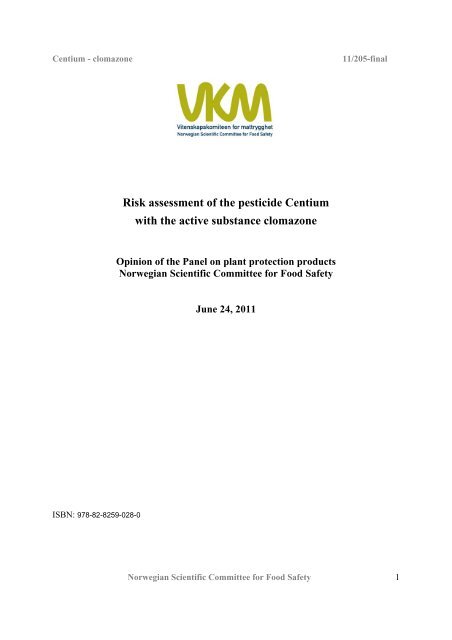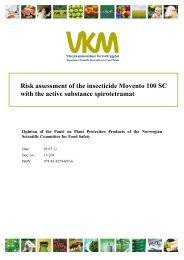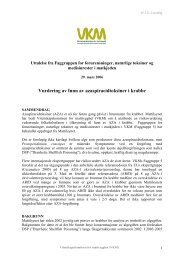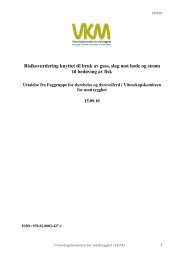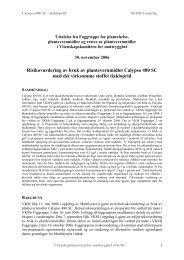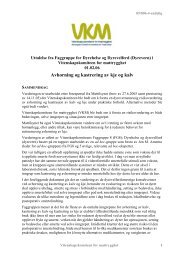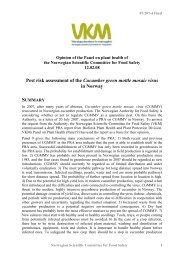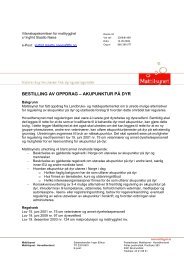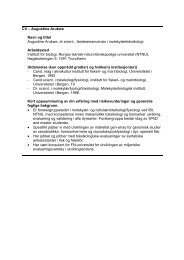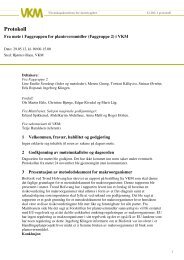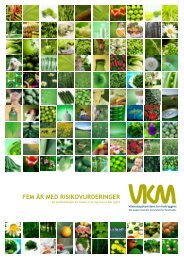Risk assessment of the pesticide Centium with the active substance ...
Risk assessment of the pesticide Centium with the active substance ...
Risk assessment of the pesticide Centium with the active substance ...
Create successful ePaper yourself
Turn your PDF publications into a flip-book with our unique Google optimized e-Paper software.
<strong>Centium</strong> - clomazone11/205-final<strong>Risk</strong> <strong>assessment</strong> <strong>of</strong> <strong>the</strong> <strong>pesticide</strong> <strong>Centium</strong><strong>with</strong> <strong>the</strong> <strong>active</strong> <strong>substance</strong> clomazoneOpinion <strong>of</strong> <strong>the</strong> Panel on plant protection productsNorwegian Scientific Committee for Food SafetyJune 24, 2011ISBN: 978-82-8259-028-0Norwegian Scientific Committee for Food Safety 1
<strong>Centium</strong> - clomazone11/205-finalSUMMARY<strong>Centium</strong> is a new product in Norway containing <strong>the</strong> <strong>active</strong> <strong>substance</strong> clomazone. The product isapplied for use as a herbicide in potato, carrot, cabbage, brussel sprout, swedes, oil seed rape, peaand bean. The Norwegian Institute for Agricultural and Environmental Research recommendapproval in potato, carrot, swedes and pea. They do not recommend approval in oil seed rape,cabbage and bean because <strong>of</strong> lacking documentation on efficacy. The Norwegian ScientificCommittee for Food Safety (VKM) was asked by <strong>the</strong> Norwegian Food Safety Authority toperform a risk <strong>assessment</strong> on human health and environmental fate <strong>of</strong> <strong>the</strong> <strong>active</strong> <strong>substance</strong> and<strong>the</strong> product. The risk <strong>assessment</strong> <strong>of</strong> <strong>the</strong> product was finalized at a meeting May 18, 2011, byVKM’s Scientific Panel on plant protection products (Panel 2). VKM Panel 2’s conclusion is asfollows:The <strong>active</strong> ingredient clomazone is <strong>of</strong> moderate acute toxicity after oral and inhalation exposureand <strong>of</strong> low dermal toxicity. The product <strong>Centium</strong> is <strong>of</strong> low acute toxicity after oral exposure, byskin contact or by inhalation; however <strong>the</strong> product may contain a co-formulant, monomericisocyanate, <strong>with</strong> sensitizing properties. Due to <strong>the</strong> lack <strong>of</strong> documentation on <strong>the</strong> monomercontent, <strong>the</strong> Panel can not evaluate <strong>the</strong> risk <strong>of</strong> sensitization. UK Poem model estimation <strong>of</strong>exposure show that exposure to operator is below AOEL and <strong>the</strong> health risk is <strong>the</strong>refore minimal.The effects observed in <strong>the</strong> dog study were considered due to <strong>the</strong> exposure <strong>of</strong> clomazone andshould <strong>the</strong>refore be used to determine <strong>the</strong> NOAEL value.The fertility index used in <strong>the</strong> two-generation study in rats is not considered relevant as a measure<strong>of</strong> critical effect. The Panel suggests to use 4000 ppm (354 mg/kg bw/day) which is <strong>the</strong> highestdose tested in <strong>the</strong> study.Dose dependent responses were not always evident in <strong>the</strong> rat teratology study, but significanteffects were found at <strong>the</strong> two highest dose levels (300 and 600 mg/kg bw/day). The observedeffects were considered adverse. The proposed NOAEL <strong>of</strong> 100 mg/kg bw/day was <strong>the</strong>reforesupported.The teratology study <strong>with</strong> rats is considered relevant for determination <strong>of</strong> acute reference dose(ARfD) since skeletal malformations can be induced after short exposure periods if <strong>the</strong> exposureis taking place during a sensitive period <strong>of</strong> foetal development.The Panel also concludes that based on <strong>the</strong> results from modeling <strong>with</strong> MACRO (4.4.2) using <strong>the</strong>Nordic groundwater scenarios and <strong>the</strong> input parameters agreed upon in <strong>the</strong> EU <strong>the</strong>re is a potentialfor contamination <strong>of</strong> groundwater exceeding <strong>the</strong> trigger value <strong>of</strong> 0.1µg/L for <strong>the</strong> <strong>active</strong> ingredientfollowing prescribed usage.Norwegian Scientific Committee for Food Safety 2
<strong>Centium</strong> - clomazone11/205-finalCONTRIBUTORSPersons working for VKM, ei<strong>the</strong>r as appointed members <strong>of</strong> <strong>the</strong> Committee or as ad hoc experts,do this by virtue <strong>of</strong> <strong>the</strong>ir scientific expertise, not as representatives for <strong>the</strong>ir employers. The CivilServices Act instructions on legal competence apply for all work prepared by VKM.Assessed by VKMs Panel on plant protection products (Panel 2)Members <strong>of</strong> Panel 2: Line Emilie Sverdrup (Chair), Christine Bjørge, Ole Martin Eklo, MereteGrung, Torsten Källqvist, Ingeborg Klingen, Marit Låg, Edgar Rivedal, Erik Ropstad, SteinarØvrebø.Scientific Coordinator from <strong>the</strong> Secretariat: Terje HaraldsenNorwegian Scientific Committee for Food Safety 3
<strong>Centium</strong> - clomazone11/205-finalTABLE OF CONTENTSummary ......................................................................................................................................21. Background ..........................................................................................................................52. terms <strong>of</strong> reference.................................................................................................................53. <strong>Risk</strong> <strong>assessment</strong>....................................................................................................................53.1. Background documentation..........................................................................................53.2. Procedure......................................................................................................................53.3. Summary by <strong>the</strong> Norwegian Food Safety Authority (hazard identification, hazardcharacterization and <strong>assessment</strong> <strong>of</strong> exposure)..........................................................................73.3.1. Identity and physical/chemical data.........................................................................73.3.2. Mammalian toxicology.............................................................................................73.3.3. Residues in food and feed.......................................................................................103.3.4. Environmental fate and ecotoxicological effects ...................................................113.3.5. Dossier quality and completeness..........................................................................123.4. Panel 2’s <strong>assessment</strong> on health...................................................................................12Summary <strong>of</strong> human toxicity/inherent properties ....................................................................12<strong>Risk</strong> characterization <strong>of</strong> health ..............................................................................................143.5. Panel 2’s <strong>assessment</strong> <strong>of</strong> environment.........................................................................153.5.1. Summary <strong>of</strong> <strong>the</strong> environmental fate........................................................................153.5.2. Environmental risk characterization......................................................................163.6. Quality <strong>of</strong> <strong>the</strong> submitted documentation ....................................................................164. Conclusion..........................................................................................................................165. Attachment .........................................................................................................................17Norwegian Scientific Committee for Food Safety 4
<strong>Centium</strong> - clomazone11/205-final1. BACKGROUNDVKM performs risk <strong>assessment</strong>s in <strong>the</strong> context <strong>of</strong> <strong>pesticide</strong> registration cf. Regulation onPesticides § 4. The Norwegian Food Safety Authority, National Registration Section, isresponsible for reviewing and evaluating <strong>the</strong> documentation submitted by <strong>the</strong> <strong>pesticide</strong> notifier.The Norwegian Food Safety Authority takes <strong>the</strong> final regulatory action regarding registration orderegistration <strong>of</strong> <strong>pesticide</strong>s based on VKMs risk <strong>assessment</strong>, along <strong>with</strong> a comparative<strong>assessment</strong> <strong>of</strong> risk and benefits and <strong>the</strong> availability <strong>of</strong> alternatives (<strong>the</strong> principle <strong>of</strong> substitution).The Norwegian Food Safety Authority submitted a request on April 15, 2011 for VKM toperform a risk <strong>assessment</strong> on use <strong>of</strong> <strong>the</strong> <strong>pesticide</strong> <strong>Centium</strong> 36 CS containing <strong>the</strong> <strong>active</strong> <strong>substance</strong>clomazone. Both <strong>the</strong> environmental and <strong>the</strong> health risk <strong>assessment</strong>s <strong>of</strong> <strong>the</strong> product were finalizedby VKM’s Panel 2 at a meeting on May 18, 2011.2. TERMS OF REFERENCETerms <strong>of</strong> reference as provided by <strong>the</strong> Norwegian Food Safety Authority are as follows:“<strong>Centium</strong> 36 CS is a new herbicide in Norway containing <strong>the</strong> <strong>active</strong> <strong>substance</strong> clomazone. Theapplication concerns use in potato, carrot, cabbage, brussels sprout, swedes, oil seed rape, peaand bean. The Norwegian Food Safety Authority would like, in this regard, an <strong>assessment</strong> <strong>of</strong> <strong>the</strong>following:The human health risk for operators related to <strong>the</strong> properties <strong>of</strong> <strong>the</strong> <strong>active</strong> <strong>substance</strong> and <strong>the</strong>product. The Panel is in particular asked to look at <strong>the</strong> following:o Establishment <strong>of</strong> NOAEL in 1-year dog study regarding adversity <strong>of</strong> <strong>the</strong> effectsobserved in <strong>the</strong> liver.o Establishment <strong>of</strong> NOAEL reproduction in two-generation study in rats related to<strong>the</strong> fertility index.o Evaluation <strong>the</strong> severity <strong>of</strong> <strong>the</strong> delayed skeletal ossifications and establishment <strong>of</strong>NOAEL in <strong>the</strong> rat teratology study.o Establishment <strong>of</strong> ARfD.o Assessment <strong>of</strong> <strong>the</strong> severity <strong>of</strong> 1 % isocyanate in <strong>the</strong> product regarding operatorexposure.Fate and behaviour in <strong>the</strong> environment <strong>with</strong> regard to <strong>the</strong> properties <strong>of</strong> <strong>Centium</strong> 36 CS andclomazone”.3. RISK ASSESSMENT3.1. Background documentationThe Panel’s risk <strong>assessment</strong> is based on <strong>the</strong> Norwegian Food Safety Authority’s evaluation(2011) <strong>of</strong> <strong>the</strong> documentation submitted by <strong>the</strong> applicant. The Norwegian Authority for FoodSafety publishes both <strong>the</strong>ir evaluation <strong>of</strong> <strong>Centium</strong> and <strong>the</strong>ir final regulatory action on <strong>the</strong>registration <strong>of</strong> <strong>the</strong> <strong>pesticide</strong> product at <strong>the</strong>ir homepage: Mattilsynet3.2. ProcedureThe first three steps <strong>of</strong> <strong>the</strong> risk <strong>assessment</strong> (hazard identification, hazard characterization and<strong>assessment</strong> <strong>of</strong> exposure) are performed by <strong>the</strong> Norwegian Food Safety Authority and involve anNorwegian Scientific Committee for Food Safety 5
<strong>Centium</strong> - clomazone11/205-final<strong>assessment</strong> <strong>of</strong> <strong>the</strong> documentation submitted by <strong>the</strong> <strong>pesticide</strong> notifier. The resulting summaryreport on hazard identification, hazard characterization and <strong>assessment</strong> <strong>of</strong> exposure, which isincluded in <strong>the</strong> present document, is <strong>the</strong>n reviewed by VKMs Panel 2. This review may result insome amendments in <strong>the</strong> original documents <strong>of</strong> both <strong>the</strong> summary report and <strong>the</strong> full reportissued by <strong>the</strong> Norwegian Food Safety Authority (2010). The fourth step (risk characterization) isbased on <strong>the</strong> three first steps and is <strong>the</strong> Panel’s conclusions or risk <strong>assessment</strong>.Health risk <strong>assessment</strong>The <strong>assessment</strong> <strong>of</strong> health risk <strong>of</strong> <strong>pesticide</strong>s is based on <strong>the</strong> adverse effects produced by <strong>the</strong> <strong>active</strong><strong>substance</strong> and product in several experimental test systems including long term animal studies.On <strong>the</strong> basis <strong>of</strong> this, limits <strong>of</strong> exposure which represent no health risk are determined. The limitstake account <strong>of</strong> <strong>the</strong> uncertainties <strong>of</strong> extrapolating data for animal to human. Then <strong>the</strong> limits arecompared to <strong>the</strong> operator exposure and human exposure to possible residues in food.UKPoem and <strong>the</strong> German model estimate <strong>of</strong> exposure are used to estimate <strong>the</strong> operator exposure.The models are based on a limited number <strong>of</strong> studies and are not validated. Thus, <strong>the</strong> models maynot always be sufficiently representative for Norwegian conditions. The limitations <strong>of</strong> modelestimates <strong>of</strong> exposure are taken into consideration when <strong>the</strong> calculated level <strong>of</strong> exposure is closeto <strong>the</strong> threshold limit for acceptable operator exposure (Acceptable Operator Exposure Level;AOEL). The Panel uses <strong>the</strong> 75 percentile <strong>of</strong> exposure <strong>assessment</strong> for both UK poem and Germanmodel. The Panel has to base <strong>the</strong>ir <strong>assessment</strong> on <strong>the</strong> models whenever exposure data for <strong>the</strong>product is not presented.The Panel makes use <strong>of</strong> a higher safety factor when calculating AOEL and ADI in cases where<strong>the</strong> product contains critical <strong>active</strong> <strong>substance</strong>s <strong>with</strong> serious adverse inherent properties (toxic toreproduction or carcinogenic effects).In order to describe <strong>the</strong> risk <strong>of</strong> operator exposure, <strong>the</strong> Panel makes use <strong>of</strong> a risk scale. The scale isbased on <strong>the</strong> ratio between <strong>the</strong> estimated exposure based on models or measured exposure in fieldstudies and <strong>the</strong> Acceptable Operator Exposure Level (AOEL). In case <strong>the</strong> estimated exposuresignificantly exceeds AOEL, use <strong>of</strong> <strong>the</strong> products may lead to increased risk for health effects.The following risk scale is used:Very high riskHigh riskMedium riskModerate riskMinimal riskmore than 500% <strong>of</strong> <strong>the</strong> limit300 – 500% <strong>of</strong> <strong>the</strong> limit150-300% <strong>of</strong> <strong>the</strong> limit110-150% <strong>of</strong> <strong>the</strong> limit<strong>the</strong> limit is not exceededThe Panel may take into consideration critical co-formulants <strong>of</strong> <strong>the</strong> product when <strong>the</strong> degree <strong>of</strong>risk is to be determined. Consequently, if a product contains critical co-formulants it may beassessed to represent higher risk than what <strong>the</strong> inherent properties <strong>of</strong> <strong>active</strong> <strong>substance</strong>s imply.Norwegian Scientific Committee for Food Safety 6
<strong>Centium</strong> - clomazone11/205-finalEnvironmental risk <strong>assessment</strong>The Norwegian Food Safety Authority asked <strong>the</strong> Panel to evaluate fate and behaviour in <strong>the</strong>environment <strong>with</strong> regard to <strong>the</strong> properties <strong>of</strong> <strong>Centium</strong> 36 CS and clomazone, and <strong>the</strong> Panel wasnot asked to evaluate <strong>the</strong> ecotoxicological effects.Traditionally <strong>the</strong> environmental risk <strong>assessment</strong> <strong>of</strong> <strong>pesticide</strong>s involves predictions <strong>of</strong> exposureconcentrations in various environmental compartments (e.g. soil and surface waters) that mayoccur after application <strong>of</strong> <strong>the</strong> <strong>pesticide</strong>.In environmental risk <strong>assessment</strong>s <strong>of</strong> <strong>pesticide</strong>s, Predicted Environmental Concentrations (PECs)are estimated by use <strong>of</strong> different scenarios for different parts <strong>of</strong> <strong>the</strong> environment (terrestrial,aquatic). The first parameter estimated is usually <strong>the</strong> initial concentration (PIEC, Predicted InitialEnvironmental Concentration), e.g. <strong>the</strong> concentration just after application (usually spraying).The fur<strong>the</strong>r exposure regime in different compartment is affected on <strong>the</strong> fate <strong>of</strong> <strong>the</strong> <strong>pesticide</strong>. Thefate is dependent on processes such as photodegradation, hydrolysis, biodegradation and sorptionto soil particles. These processes are studied in several standardised laboratory tests. In addition,field tests are used to study <strong>the</strong> dissipation <strong>of</strong> <strong>the</strong> <strong>pesticide</strong> in various agricultural soils.Based on <strong>the</strong> experimental fate studies, factors describing different fate processes may be derivedand used in models that describe <strong>the</strong> fate <strong>of</strong> <strong>the</strong> <strong>pesticide</strong> in <strong>the</strong> soil as well as <strong>the</strong> transport tosurface water and ground water. The concentrations <strong>of</strong> <strong>the</strong> <strong>pesticide</strong> in water are estimated by use<strong>of</strong> models <strong>with</strong> relevant scenarios based on EUs FOCUS-scenarios.3.3. Summary by <strong>the</strong> Norwegian Food Safety Authority (hazard identification,hazard characterization and <strong>assessment</strong> <strong>of</strong> exposure)<strong>Centium</strong> 36 CS is a new product in Norway containing <strong>the</strong> new <strong>active</strong> <strong>substance</strong> clomazone. Theproduct is applied for use as an herbicide in potato, carrot, cabbage, brussels sprout, swedes, oilseed rape, pea and bean. The Norwegian Institute for Agricultural and Environmental Researchrecommend approval in potato, carrot, swedes and pea. They do not recommend approval in oilseed rape, cabbage and bean because <strong>of</strong> lacking documentation on efficacy. It will be carried outmore efficacy trials during <strong>the</strong> season 2011.The standardized area dose is 0,25 l (90 g a.s.) per ha. There should be maximum one applicationat uses on field. The application method used for <strong>Centium</strong> is tractor-mounted sprayers.Clomazone is a selective, systemic herbicide absorbed by roots and shoots and translocatedupwards. Clomazone belong to chemical family isoxazolidinones and HRAC group F3, inhibitor<strong>of</strong> carotenoid biosyn<strong>the</strong>sis. In presence <strong>of</strong> high rates <strong>of</strong> clomazone, newly developing tissuebecomes white. At lower rates plant pigmentation is partly inhibited and <strong>the</strong> developing tissuemay be pale green or yellow.Product name3.3.1. Identity and physical/chemical data<strong>Centium</strong> 36 CSActive <strong>substance</strong>FormulationClomazoneliquid capsule suspension (CS)Norwegian Scientific Committee for Food Safety 7
<strong>Centium</strong> - clomazone11/205-finalConcentration <strong>of</strong><strong>active</strong> <strong>substance</strong>IUPAC-name360g/L2-(2-chlorobenzyl)-4,4-dimethyl-1,2-oxazolidin-3-oneCAS number 81777-89-1Structural formulaOClCH 2NCH 3CH 3OMolecular weightSolubility in waterVapour pressureHenrys law constantlog Pow239.7 g/moleVery high, 1102 mg/l (23 °C)Medium, 1.92 x 10 -2 Pa (20 °C)Medium, 4.2 x 10 -3 Pa m3/molMedium, 2,54 (23 °C)pKaNo dissociation3.3.2. Mammalian toxicologyClomazoneToxicokineticsAbsorptionClomazone is rapidly and extensively absorbed after oral administration. Absorption rates <strong>of</strong> 87%after low dosing and up till 100% after high dosing were observed <strong>with</strong>in 48 hrs based on urinaryexcretion and intravenous study. Peak blood concentrations were seen after 4 hours post dosing.The extent <strong>of</strong> absorption after oral administration can be considered as complete.DistributionResidual tissue levels detected distribution after 7 days post dosing. Residual tissue levels werevery low after oral low dose (5 mg/kg b.w.) and medium dose (50 mg/kg b.w.) but higherconcentrations were found after high dose (900 mg/kg b.w.). At high dose higher levels werefound primarily in liver, kidney, lung, blood, hair and carcass.MetabolismClomazone was almost completely metabolised, as indicated by <strong>the</strong> absence <strong>of</strong> non-metabolisedparent compound and <strong>the</strong> presence <strong>of</strong> a total <strong>of</strong> 14 metabolites identified in urine or faeces.Extensive first pass metabolism seemed to take place after oral administration. The sixpredominant metabolites were FMC 60217, FMC 83918, FMC 87010, FMC 87009, FMC 87008Norwegian Scientific Committee for Food Safety 8
<strong>Centium</strong> - clomazone11/205-finaland FMC 87011 (see appendix I in <strong>the</strong> DAR). The same metabolites were found in urine andfaeces, but in different concentrations. After repeated dosing <strong>the</strong> concentrations <strong>of</strong> threemetabolites were significantly increased, indicating development <strong>of</strong> an enzyme inducing activityon mixed function oxidase (MFO). The metabolites were hydroxylated derivatives <strong>of</strong> <strong>the</strong> parentcompound, mono-, di- and trihydroxylated metabolites, and additional metabolites were formedby oxidation and opening <strong>of</strong> <strong>the</strong> 3-isoxazolidone (heterocyclic) ring.EliminationThe elimination <strong>of</strong> clomazone and its metabolites was fast and complete <strong>with</strong> a cumulativeexcretion value close to 100% after 7 days but <strong>the</strong> majority <strong>of</strong> <strong>the</strong> excretion occurred <strong>with</strong>in <strong>the</strong>first two days. About 70% was excreted in urine and approximately 30% in faeces. Eliminationvia expired air was negligible (0.01% <strong>of</strong> administered dose). The potential for bioaccumulation <strong>of</strong>clomazone is low. The level <strong>of</strong> <strong>the</strong> parent compound found in urine and faeces was very low andmetabolites were excreted as free compounds (i.e. nonconjugated) or as conjugates. The 14-dayrepeated dosing did not have significant influence on absorption, elimination, distribution <strong>of</strong>parent compound and metabolites in tissues. Cumulative excretion was complete <strong>with</strong>in 7 dayspost administration, <strong>with</strong> a slight shift towards increased urinary excretion compared to <strong>the</strong> singledose group. In general some minor variances in rate and extent <strong>of</strong> absorption, biotranformationand excretion may occur which could be attributed to sex and/or size <strong>of</strong> administered dose.Acute toxicity:Clomazone is <strong>of</strong> moderate acute toxicity after oral and inhalation exposure and <strong>of</strong> low dermaltoxicity. The proposed classification is Xn, R20/22 Harmful by inhalation and if swallowed.(Acute Tox. 4 H332 Harmful if inhaled and Acute Tox. 4 H 302 Harmful if swallowed).Irritation and sensitisation:Clomazone was not found to be nei<strong>the</strong>r a skin- or eye irritant nor a skin sensitiser.Genotoxicity:All in vitro and in vivo genotoxicity studies were negative; hence clomazone is not <strong>of</strong> genotoxicconcern.Sub-chronic toxicity:In <strong>the</strong> short term studies, <strong>the</strong> liver was <strong>the</strong> target organ for all <strong>the</strong> species (rat, mouse and dog)<strong>with</strong> increased absolute and/or relative weight, alterations in hepatocytes (megalocytosis), andrelated changes in clinical chemistry parameters (elevated cholesterol levels). In a 28-day dermalstudy in rats, <strong>the</strong>re was no evidence <strong>of</strong> adverse effects.Chronic toxicity and carcinogenicity:Long-term toxicity and carcinogenicity studies in rats and mice showed liver changes (increasedweight, hepatocytomegaly) and persistent thymus glands (only in female mice). Clomazone is nota carcinogen in animal-studies.Reproductive toxicity:Two-generation study in rats showed reduced maternal body weights, maternal body weight gainand foodconsumption in parental animals in <strong>the</strong> two high dose groups. No effects were seen at <strong>the</strong><strong>of</strong>fsprings, while reduced fertility index in <strong>the</strong> high dose level was observed.Norwegian Scientific Committee for Food Safety 9
<strong>Centium</strong> - clomazone11/205-finalTeratology:In <strong>the</strong> rat teratogenicity study, <strong>the</strong> maternal toxicity was manifested by a decrease in meanmaternal body weight and food consumption and clinical signs. Foetal effects were a decreasedbody weight, and increased incidence <strong>of</strong> delayed ossifications/absence <strong>of</strong> skeletal bones andvisceral abnormalities. In <strong>the</strong> rabbit teratogenicity study, <strong>the</strong>re was no relevant increasedincidence <strong>of</strong> malformations, developmental effects or abnormalities in foetuses. The high doseproduced maternal toxicity manifested by decreased body weight, decreased or no defecation, 3deaths, 4 abortions and some clinical signs (ataxia and red vaginal discharge).Delayed neurotoxicity:No studies were available for evaluation.Special studies:No studies were submitted.Medical data:No human data was available. According to occupational physicians no clinically relevant healthproblems associated <strong>with</strong> Clomazone production has ever been observed since <strong>the</strong> start in 1986.<strong>Centium</strong> 36 CSCo-formulants:The product does contain a co-formulant which meets <strong>the</strong> criteria for Xn; Harmful, R42 Maycause sensitisation by inhalation (Resp Sens Cat.1 H334 May cause allergy or asthmasymptoms or breathing difficulties if inhaled).Acute toxicity:<strong>Centium</strong> 36 CS is not harmful by swallowing, skin contact or by inhalation. Hence, noclassification for acute oral, dermal and inhalation toxicity is required.Irritation and sensitisation: <strong>Centium</strong> 36 CS is nei<strong>the</strong>r irritating to <strong>the</strong> eye and skin nor found to bea dermal sensitiser.Dermal absorption:Based on <strong>the</strong> in vitro study <strong>with</strong> human skin <strong>the</strong> dermal absorption was 0.59% for <strong>the</strong> undilutedconcentrate and 15.40% for <strong>the</strong> diluted solution.Operator, worker and bystander exposureUK Poem model estimate <strong>of</strong> exposure demonstrate that <strong>the</strong> operator exposure is below AOEL.Similarly, no significant levels <strong>of</strong> exposure are expected <strong>with</strong> respect to workers or bystanders.However, as a result <strong>of</strong> <strong>the</strong> hazard classification, a face shield <strong>with</strong> assisted airflow and glovesare necessary PPE to be worn during mixing and loading operations and applications, due to <strong>the</strong>risk <strong>of</strong> a c<strong>of</strong>ormulant that may cause sensitisation by inhalation.3.3.3. Residues in food and feedThis is not included in this report.Norwegian Scientific Committee for Food Safety 10
<strong>Centium</strong> - clomazone11/205-final3.3.4. Environmental fate and ecotoxicological effectsDegradation in soilThe initial metabolism <strong>of</strong> clomazone involves cleavage <strong>of</strong> <strong>the</strong> isoxazolidinone ring and <strong>the</strong>n loss<strong>of</strong> <strong>the</strong> carbonyl carbon as CO 2 . This results in <strong>the</strong> formation <strong>of</strong> a couple <strong>of</strong> short livedmetabolites. Based on normalised (adjusted to 20 °C and pF 2) SFO (Single First Order) valuesfrom <strong>the</strong> six studies initially accepted by RMS <strong>the</strong> degradation rates varied between high andlow, <strong>with</strong> DT50s ranging from 7 to 265 days and a geometric mean <strong>of</strong> 52 days. DT90 valuesrange from 68 to 499 days. Excluding some <strong>of</strong> <strong>the</strong> studies, as suggested by EFSA, results in anormalised DT50 <strong>of</strong> 37 days. The amount <strong>of</strong> bound residues varied between 12 and 25 % butdepending on soil moisture and temperature it could be lower. The amount <strong>of</strong> CO 2 was measuredto be between 2.8 and 77 %. No metabolites were present at levels > 3.7 % <strong>of</strong> appliedradioactivity (AR). There are indications that <strong>the</strong> degradation <strong>of</strong> clomazone is somewhatbiphasic. At 10 °C <strong>the</strong> degradation rate is medium <strong>with</strong> DT50: 20 days and DT90: 68 days. Theanaerobic degradation rate could not be calculated as <strong>the</strong>re were too few time points in <strong>the</strong> study.Degradation obviously occurs though due to <strong>the</strong> fact that both CO 2 is measured in relatively highamounts after only 30 days and bound residues amount to 15 % <strong>of</strong> AR <strong>with</strong>in 30 days. In additiona metabolite (FMC 65317) was identified up to 38 % <strong>of</strong> AR <strong>with</strong>in <strong>the</strong> end <strong>of</strong> <strong>the</strong> study. There areno data submitted on <strong>the</strong> fate and behaviour <strong>of</strong> this metabolite. Photolysis is not an importantroute <strong>of</strong> degradation for clomazone in soil. The dissipation <strong>of</strong> clomazone in <strong>the</strong> field is medium tomoderate in <strong>the</strong> studies assumed to be <strong>of</strong> most relevance for Norway, <strong>with</strong> DT50s <strong>of</strong> 15-74 daysand a geometric mean <strong>of</strong> 43 days. DT90: 105-297 days. In general clomazone residues were onlyfound in <strong>the</strong> upper 0-20 cm <strong>of</strong> <strong>the</strong> soil but very low concentrations were also observed as deep as15-30 cm. Only <strong>the</strong> dissipation <strong>of</strong> clomazone was studied in <strong>the</strong> field studies submitted. Therewere no observations on <strong>the</strong> occurrence or dissipation <strong>of</strong> metabolites.Sorption/mobilityThe sorption <strong>of</strong> clomazone to soil can be classified as moderate to high <strong>with</strong> Kf: 1.5-7.4 (average3.6) and Koc: 139-608 (average 287). 48 hour 1/n values varied between 0.82 and 1.00, <strong>with</strong> anaverage value <strong>of</strong> 0.91. Based on <strong>the</strong> amount <strong>of</strong> radioactivity in <strong>the</strong> leachate (0-2.7 %) <strong>of</strong> <strong>the</strong>different columns, fresh and aged, <strong>the</strong> degree <strong>of</strong> mobility can be classified as low to high.Clomazone was identified in <strong>the</strong> leachate <strong>of</strong> several columns.Degradation in waterClomazone was hydrolytically stable at 25 °C and at each pH (4.7, 7.0, 9.3) over a period <strong>of</strong> atleast 6 weeks. Photolysis is not an important degradation pathway for clomazone in water. Threestudies all indicate that clomazone is very slowly decomposed in water irradiated both <strong>with</strong>natural and artificial sunlight. Clomazone is not easily degradable. In a water/sediment study <strong>the</strong>degradation rate <strong>of</strong> clomazone can be classified as medium <strong>with</strong> DT50: 40-67 days (wholesystem), geometric mean 52 days. DT90: 139-221 days. There was hardly any mineralization <strong>of</strong>clomazone in <strong>the</strong> systems. Bound residues amounted to 3.4-15 % after 100 days. After 100 days79 % <strong>of</strong> <strong>the</strong> applied radioactivity was still present in <strong>the</strong> water phase and <strong>of</strong> this 37 % wasidentified as clomazone. 7 % <strong>of</strong> AR was detected in <strong>the</strong> sediment phase after 100 days. Themetabolites FMC 65317 and FMC 55657 were identified in <strong>the</strong> water phase at maximumamounts <strong>of</strong> 12-28 % <strong>of</strong> AR in both systems but <strong>the</strong>re are no data submitted on <strong>the</strong>se metabolites.Norwegian Scientific Committee for Food Safety 11
<strong>Centium</strong> - clomazone11/205-finalFate in airA vapour pressure <strong>of</strong> 1.92x10 -2 Pa and a Henry’s law constant <strong>of</strong> 4.2 x10 -3 Pa m 3 mol -1 indicatethat <strong>the</strong> probability <strong>of</strong> vaporization is medium for clomazone. In a evaporation study 81 % <strong>of</strong> <strong>the</strong>applied radioactivity was recovered after 24 hours and <strong>the</strong> amount <strong>of</strong> radio-labelled volatilecompounds was only 6.9 %, indicating that evaporation <strong>of</strong> clomazone from soil surfaces wouldnot be a problem.ExposurePIEC (predicted initial environmental concentration) in soil after <strong>the</strong> application <strong>of</strong> 120 g <strong>active</strong><strong>substance</strong>/ha is 0.16 mg/kg (max concentration <strong>the</strong> first year). A PEC plateau <strong>of</strong> about 0.46 mg/kg isreached after about 13 years <strong>of</strong> annual use.The leaching <strong>of</strong> clomazone to groundwater at 9 European locations was modelled using <strong>the</strong>FOCUS groundwater scenarios and <strong>the</strong> <strong>pesticide</strong> leaching model FOCUS PELMO 3.3.2. BothOkehampton and Piacenza gave results above <strong>the</strong> threshold value <strong>of</strong> 0.1 µg/L. Modelling <strong>with</strong>Norwegian, Swedish end Danish scenarios using MACRO also gave results above <strong>the</strong> threshold,<strong>with</strong> <strong>the</strong> Swedish scenario Önnestad giving <strong>the</strong> highest value <strong>of</strong> 0.94 µg/l when applyingclomazone in potatoes. In potatoes <strong>the</strong> simulation also was run <strong>with</strong> half <strong>the</strong> dose, but <strong>the</strong>threshold was never<strong>the</strong>less exceeded in some <strong>of</strong> <strong>the</strong> scenarios. The same input parameters wereused in all <strong>the</strong> modelling except that 1/n was changed in one simulation to see <strong>the</strong> effect on <strong>the</strong>results. An increase in 1/n gave higher PEC values in all scenarios.Aquatic risk <strong>assessment</strong> was conducted based on data for <strong>the</strong> <strong>active</strong> <strong>substance</strong>. PEC values insurface water were determined using <strong>the</strong> FOCUS Surface Water Tool for Exposure Predictions(Steps 1 & 2) and a maximum application rate <strong>of</strong> 120 g a.s./ha. The initial PECsw was calculatedto be 0.03023 mg/L based on FOCUS Step 1. Based on FOCUS Step 2, <strong>the</strong> initial PECsw wascalculated to be 0.00913 mg/L.3.3.5 Dossier quality and completenessThe dossier is complete and adequate as a basis for evaluation <strong>of</strong> <strong>the</strong> <strong>active</strong> <strong>substance</strong>,metabolites and product.3.4. Panel 2’s <strong>assessment</strong> on health3.4.1 Summary <strong>of</strong> human toxicity/inherent propertiesIn <strong>the</strong> terms <strong>of</strong> reference it was stated that <strong>the</strong> panel in particular should look at <strong>the</strong> following: Establishment <strong>of</strong> NOAEL in 1-year dog study regarding adversity <strong>of</strong> <strong>the</strong> effects observedin <strong>the</strong> liver. Establishment <strong>of</strong> NOAEL reproduction in two-generation study in rats related to <strong>the</strong>fertility index. Evaluation <strong>of</strong> <strong>the</strong> severity <strong>of</strong> <strong>the</strong> delayed skeletal ossifications and establishment <strong>of</strong>NOAEL in <strong>the</strong> rat teratology study. Establishment <strong>of</strong> ARfD. Assessment <strong>of</strong> <strong>the</strong> severity <strong>of</strong> 1 % isocyanate in <strong>the</strong> product regarding operator exposure.Norwegian Scientific Committee for Food Safety 12
<strong>Centium</strong> - clomazone11/205-finalThe panel discussed <strong>the</strong>se points in-depth:Establishment <strong>of</strong> NOAEL in 1-year dog study regarding adversity <strong>of</strong> <strong>the</strong> effects observed in <strong>the</strong>liver.EFSA and <strong>the</strong> Norwegian Food Safety Authority proposed a NOAEL <strong>of</strong> 500 ppm (13.3/14.4mg/kg bw/day in males and females respectively) based on elevated total cholesterol levels assign <strong>of</strong> liver toxicity and organ weight changes (a/r liver weight, a/r ovary and relative brain) in<strong>the</strong> two highest dose groups. Fur<strong>the</strong>rmore, <strong>the</strong>re was mild, transient anaemia in <strong>the</strong> high dosegroup following 6 month <strong>of</strong> exposure. The liver was <strong>the</strong> target organ.The Panel considered <strong>the</strong> elevated total cholesterol levels as adverse effects. The organ weightchanges are indications <strong>of</strong> effects, but <strong>the</strong>re were no morphological changes upon microscopicexamination <strong>of</strong> <strong>the</strong> liver. However, <strong>the</strong> Panel considered that <strong>the</strong> effects were caused by <strong>the</strong>exposure and should <strong>the</strong>refore be used in <strong>assessment</strong> <strong>of</strong> NOAEL.Establishment <strong>of</strong> NOAEL reproduction in two-generation study in rats related to <strong>the</strong> fertilityindex.Proposed NOAEL from Mattilsynet (reproduction): 2000 ppm (174 mg/kg bw/day) based onreduced fertility index in <strong>the</strong> high dose group. EFSA has proposed a NOAEL <strong>of</strong> 4000 ppm (354mg/kg bw/day) which is <strong>the</strong> highest dose tested.The fertility index is a measure <strong>of</strong> libido (no. animals <strong>with</strong> implantations/no. <strong>of</strong> matings x 100)and considered as an unspecific measure <strong>of</strong> reproduction, since it can be affected by manyfactors. It is remarkable that a reduction in <strong>the</strong> fertility index was found only in <strong>the</strong> F1”b”litterand not in <strong>the</strong> F1”a”, F2”a” and F2”b” litters. The opinion <strong>of</strong> <strong>the</strong> Panel is that <strong>the</strong> fertilty index isnot relevant as a measure <strong>of</strong> critical effect in this study. This is in agreement <strong>with</strong> EFSAsproposal.Evaluation <strong>of</strong> <strong>the</strong> severity <strong>of</strong> <strong>the</strong> delayed skeletal ossifications and establishment <strong>of</strong> NOAEL in<strong>the</strong> rat teratology study.Proposed NOAEL (developmental): 100 mg/kg bw/day based on decreased female foetal bodyweight, significant increase in <strong>the</strong> incidence <strong>of</strong> foetal visceral anomalies (increased incidence <strong>of</strong>hydroureter) and in skeletal variations (delayed ossification) in <strong>the</strong> two high dose groups.A clear dose-effect relationship was not always evident, but significant effects were found at <strong>the</strong>two highest dose levels (300 and 600 mg/kg bw/day). The observed effects occurred only in <strong>the</strong>presence <strong>of</strong> maternal toxicity. The panel considered that <strong>the</strong> observed effects can be serious for<strong>the</strong> <strong>of</strong>fspring. The minor malformation and some <strong>of</strong> <strong>the</strong> indicators <strong>of</strong> delayed ossificationreported were higher than <strong>the</strong> historical control values.The Panel is asked to consider establishment <strong>of</strong> ARfD.The Panel concludes that <strong>the</strong> teratology study <strong>with</strong> rats is relevant for determination <strong>of</strong> acutereference dose (ARfD). US-EPA has also used <strong>the</strong> same study for establishment <strong>of</strong> ARfD. Thereason for this is: Skeletal malformations can be induced after short exposure periods if <strong>the</strong>exposure is during a sensitive period <strong>of</strong> foetal development.Norwegian Scientific Committee for Food Safety 13
<strong>Centium</strong> - clomazone11/205-finalThe Panel is asked to assess <strong>the</strong> severity <strong>of</strong> 1 % isocyanate in <strong>the</strong> product regarding operatorexposure.The Panel discussed <strong>the</strong> inherent properties <strong>of</strong> isocyanate. The <strong>substance</strong> is very allergenic andcan provoke asthma and allergic skin reactions as a monomer, but not as a polymer. Thedocumentation <strong>of</strong> isocyanate in <strong>the</strong> microcapsule in <strong>the</strong> preparation is very scarce. TheNorwegian Food Safety Authority has asked <strong>the</strong> manufacturer about <strong>the</strong> isocyanate in <strong>the</strong>microcapsule but <strong>the</strong> answer was not clear. They claim that <strong>the</strong> content <strong>of</strong> monomer in <strong>the</strong>product is low. Due to <strong>the</strong> lack <strong>of</strong> documentation on <strong>the</strong> monomer content <strong>the</strong> Panel can notevaluate <strong>the</strong> risk <strong>of</strong> sensitization.National norms are set as follows:ADI – Acceptable Daily Intake0.133 mg/kg bw/day based on applying a 100-fold <strong>assessment</strong> factor to NOAEL <strong>of</strong> 13.3 mgclomazone/kg bw/day determined in <strong>the</strong> 1-year dog study. The target organ in long term toxicitystudies is <strong>the</strong> liver, and <strong>the</strong> dog is <strong>the</strong> most sensitive species. The uncertainty factor accounts forinterspecies extrapolation (10X) and intraspecies variability (10X).AOEL - Acceptable Operator Exposure Level0.133 mg/kg bw/day based on applying a 100-fold <strong>assessment</strong> factor to <strong>the</strong> NOAEL <strong>of</strong> 13.3 mgclomazone/kg bw determined in <strong>the</strong> 1-year dog study. In consideration <strong>of</strong> <strong>the</strong> almost completeabsorption after oral uptake, 100% can be set as <strong>the</strong> level <strong>of</strong> oral absorption, thus removing <strong>the</strong>need for any correction for this aspect.ARfD1 mg/kg based on applying a 100-fold <strong>assessment</strong> factor to <strong>the</strong> NOAEL <strong>of</strong> 100 mg clomazone/kgbw determined in <strong>the</strong> rat teratology study.Metabolites and impurities – possible exposure to humans via <strong>the</strong> environmentNo relevant metabolites are identified.3.4.2. <strong>Risk</strong> characterization <strong>of</strong> healthHealth risk due to human exposureThe Panel has based <strong>the</strong>ir risk characterization for operators on <strong>the</strong> exposure- and dose-response<strong>assessment</strong>s presented in section 3.3.1 by applying <strong>the</strong> risk scale described in section 3.2.Operator, worker and bystander exposureOperator exposureUK Poem model estimate <strong>of</strong> exposure indicates that <strong>the</strong> exposure <strong>of</strong> operator is below AOEL.However, as a result <strong>of</strong> <strong>the</strong> hazard classification, a face shield <strong>with</strong> assisted airflow and glovesare necessary personal protective equipment to be worn during mixing and loading operationsand applications, due to <strong>the</strong> risk <strong>of</strong> a c<strong>of</strong>ormulant that may cause sensitisation by inhalation (R42)Norwegian Scientific Committee for Food Safety 14
<strong>Centium</strong> - clomazone11/205-finalWorker exposure<strong>Centium</strong> 36 CS is applied to <strong>the</strong> soil just after planting/sowing as a pre-emergence herbicidetreatment and <strong>the</strong>refore workers are not required to re-enter <strong>the</strong> field during <strong>the</strong> weeks followingtreatment.Bystander exposureIn light <strong>of</strong> <strong>the</strong> application method used for <strong>Centium</strong> 36 CS (downward spray using conventionaltractor mounted hydraulic sprayer), bystanders are exposed to low quantities <strong>of</strong> spray comparedto operators.Health risk due to residues in products for consumptionNot included in <strong>the</strong> terms <strong>of</strong> reference.3.5. Panel 2’s <strong>assessment</strong> <strong>of</strong> environment3.5.1. Summary <strong>of</strong> <strong>the</strong> environmental fatePanel 2 has reviewed <strong>the</strong> actual documentation and points out <strong>the</strong> following inherent properties <strong>of</strong><strong>the</strong> product, <strong>the</strong> <strong>active</strong> <strong>substance</strong> and possible metabolites:Degradation route in soil.In <strong>the</strong> EU evaluation process, concern has been raised on <strong>the</strong> validity <strong>of</strong> <strong>the</strong> degradation routestudies due to low recoveries and lack <strong>of</strong> information, since only one study is considered as validand acceptable as a degradation route study. Aerobic studies show minor amounts <strong>of</strong> metabolitescompared to anaerobic studies where a major metabolite is detected at 37.9% AR after 60 days.Degradation rate in soil.On <strong>the</strong> degradation rate laboratory studies, <strong>the</strong> Rapporteur Member State (RMS) questions <strong>the</strong>validity <strong>of</strong> <strong>the</strong> originally submitted data in <strong>the</strong> degradation rate laboratory studies. Some <strong>of</strong> <strong>the</strong>degradation rate studies lack sufficient numbers <strong>of</strong> sampling dates suffers from low recovery andare performed at too high experimental temperature. Only three <strong>of</strong> nine studies were accepted byEFSA which <strong>the</strong>n decided as a consequence that <strong>the</strong> longest DT50 value <strong>of</strong> 167 days wasrecommended for <strong>the</strong> calculations <strong>of</strong> <strong>the</strong> predicted environmental concentration (PEC). EFSAconsidered that <strong>the</strong> 1st order kinetics was sufficient to describe <strong>the</strong> degradation rate <strong>of</strong> clomazone(EFSA Scientific Report (2007)).Sorption and mobility in soil.Sorption and Kd values varies from 1.4 -7.42 which is considered to be from medium to lowmobility by RMS. The Freundlich exponent (1/n) values for sorption is 0.81- 0.93, which meansnon-linear sorption. 1/n is a very sensitive parameter for <strong>the</strong> prediction <strong>of</strong> (PEC) and studiesindicate that <strong>the</strong> mobility <strong>of</strong> clomazone is low to high in soil. By EFSA and according to FOCUSguidelines <strong>the</strong> mean value for 1/n (0.88) was selected for calculating PEC.Norwegian Scientific Committee for Food Safety 15
<strong>Centium</strong> - clomazone11/205-finalPEC groundwater.The models are very sensitive to both DT50 and to 1/n as input parameters. Calculations <strong>with</strong> <strong>the</strong>EUs FOCUS-scenarios and <strong>the</strong> model PELMO show that groundwater concentrations exceeded<strong>the</strong> trigger value <strong>of</strong> 0.1µg/L in two <strong>of</strong> six scenarios in oilseed rape <strong>with</strong> yearly application. Inpotatoes <strong>with</strong> lower dose but <strong>with</strong> irrigation one <strong>of</strong> nine scenarios exceeded <strong>the</strong> trigger value.EFSA recommended that a second model should have been considered to calculate PEC. Themodel MACRO has been used by The Norwegian Food Safety Authority to simulate leaching togroundwater. Using <strong>the</strong> same input parameters as agreed upon in <strong>the</strong> EU and half <strong>of</strong> <strong>the</strong>recommended application rate (450g/ha) <strong>the</strong> trigger value was exceeded in three <strong>of</strong> <strong>the</strong> Nordicscenarios.Degradation in waterDegradation studies <strong>of</strong> 14C-labelled clomazone in water/sediment systems showed mediumprimary degradation (DT50 40-67 days) but insignificant mineralisation. After 100 days 79% <strong>of</strong><strong>the</strong> added radioactivity was found in <strong>the</strong> water phase and only 7% in <strong>the</strong> sediment. Two majormetabolites were identified in <strong>the</strong> water phase.PEC surface water.PEC to surface water was not considered as toxicity to aquatic organisms is low3.5.2 Environmental risk characterizationEcotoxicological risks are not included in <strong>the</strong> terms <strong>of</strong> reference.3.6. Quality <strong>of</strong> <strong>the</strong> submitted documentationPanel 2 is <strong>of</strong> <strong>the</strong> opinion that <strong>the</strong> documentation submitted to VKM is adequate as a basis for anevaluation <strong>of</strong> <strong>the</strong> <strong>active</strong> <strong>substance</strong>, <strong>the</strong> metabolites, and for <strong>the</strong> technical material.4. CONCLUSIONVKMs Panel 2 concludes as following:The <strong>active</strong> ingredient clomazone is <strong>of</strong> moderate acute toxicity after oral and inhalation exposureand <strong>of</strong> low dermal toxicity. The product <strong>Centium</strong> is not harmful by swallowing, skin contact orby inhalation; however <strong>the</strong> product may contain a co-formulant, monomeric isocyanate, <strong>with</strong>sensitizing properties. Due to <strong>the</strong> lack <strong>of</strong> documentation on <strong>the</strong> monomer content, <strong>the</strong> Panel cannot evaluate <strong>the</strong> risk <strong>of</strong> sensitization. UK Poem model estimation <strong>of</strong> exposure show that exposureto operator is below AOEL and <strong>the</strong> health risk is <strong>the</strong>refore minimal.The effects observed in <strong>the</strong> dog study were considered due to <strong>the</strong> exposure <strong>of</strong> clomazone andshould <strong>the</strong>refore be used to determine <strong>the</strong> NOAEL value.Norwegian Scientific Committee for Food Safety 16
<strong>Centium</strong> - clomazone11/205-finalThe fertility index used in <strong>the</strong> two-generation study in rats is not considered relevant as a measure<strong>of</strong> critical effect. The Panel suggests to use 4000 ppm (354 mg/kg bw/day) which is <strong>the</strong> highestdose tested in <strong>the</strong> study.Dose dependent responses were not always evident in <strong>the</strong> rat teratology study, but significanteffects were found at <strong>the</strong> two highest dose levels (300 and 600 mg/kg bw/day). The observedeffects were considered adverse. The proposed NOAEL <strong>of</strong> 100 mg/kg bw/day was <strong>the</strong>reforesupported.The teratology study <strong>with</strong> rats is considered relevant for determination <strong>of</strong> acute reference dose(ARfD) since skeletal malformations can be induced after short exposure periods if <strong>the</strong> exposureis taking place during a sensitive period <strong>of</strong> foetal development.The Panel also concludes that based on <strong>the</strong> results from modeling <strong>with</strong> MACRO (4.4.2) using <strong>the</strong>Nordic groundwater scenarios and <strong>the</strong> input parameters agreed upon in <strong>the</strong> EU <strong>the</strong>re is a potentialfor contamination <strong>of</strong> groundwater exceeding <strong>the</strong> trigger value <strong>of</strong> 0.1µg/L for <strong>the</strong> <strong>active</strong> ingredientfollowing prescribed usage.5. ATTACHMENTThe Norwegian Food Safety Authority’s evaluation <strong>of</strong> <strong>the</strong> documentation submitted by <strong>the</strong>applicant, following application for registration <strong>of</strong> <strong>the</strong> herbicide <strong>Centium</strong> 36 CS (clomazone),2011.REFERENCESEFSA Scientific Report (2007) 109, 1-73. “Conclusion on <strong>the</strong> peer review <strong>of</strong> clomazone”.EU Draft Assessment Report (DAR) (Rapporteur Member State Denmark, February 2005,Corrigendum revised June 2005, December 2006, May 2007). “Clomazone, Volume 3”.Final addendum to <strong>the</strong> Draft Assessment Report (DAR) (Denmark, June 2007): “Initial risk<strong>assessment</strong> provided by <strong>the</strong> rapporteur Member State Denmark for <strong>the</strong> existing <strong>active</strong> <strong>substance</strong>Clomazone <strong>of</strong> <strong>the</strong> third stage Part A as referred to in article 8(1) <strong>of</strong> Council Directive91/414/EEC”.Norwegian Scientific Committee for Food Safety 17


